A Simulation Study of Noise Exposure in Sledge-Based Cable Yarding Operations
Abstract
1. Introduction
2. Materials and Methods
2.1. Data Sourcing
2.2. Statistical Analysis
2.3. Simulation of Noise Exposure
3. Results
3.1. Statistics for the Source Data and Data Resampling
3.2. Simulated Noise Exposure
4. Discussion
5. Conclusions
Author Contributions
Funding
Data Availability Statement
Acknowledgments
Conflicts of Interest
Appendix A
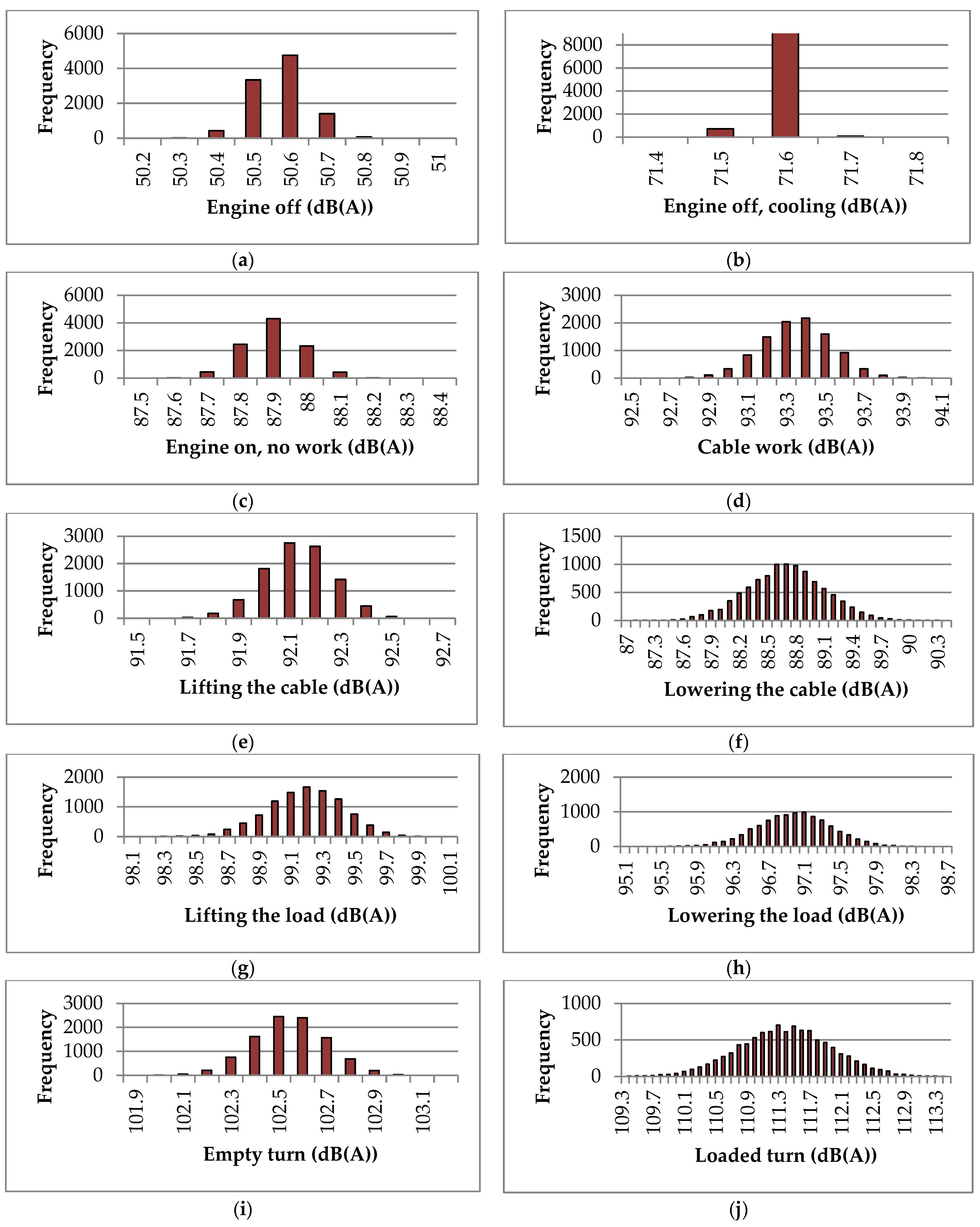
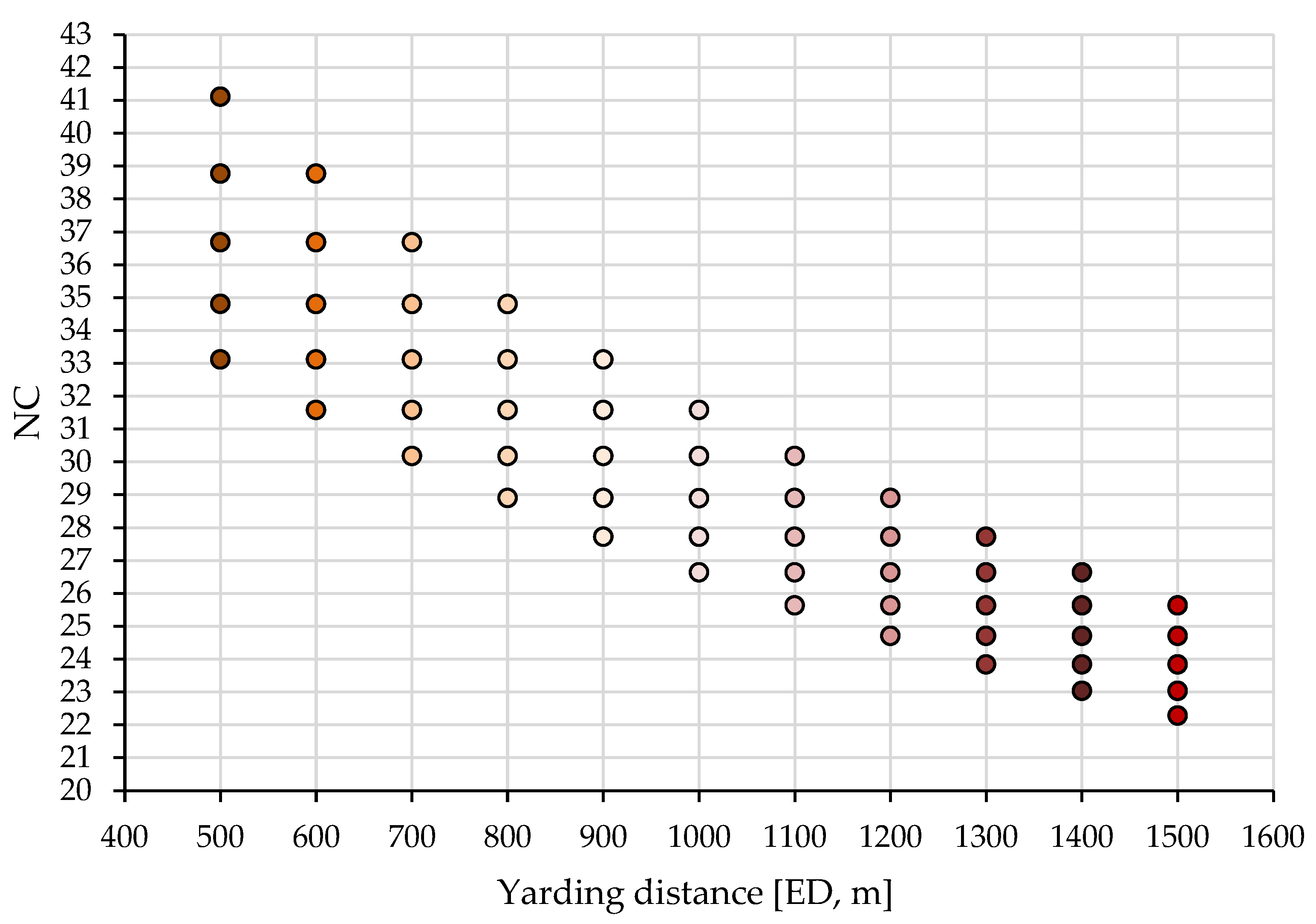
References
- Heinimann, H.R. Forest operations engineering and management—The ways behind and ahead of a scientific discipline. Croat. J. For. Eng. 2007, 28, 107–121. [Google Scholar]
- Marchi, E.; Chung, W.; Visser, R.; Abbas, D.; Nordfjell, T.; Mederski, P.S.; McEwan, A.; Brink, M.; Laschi, A. Sustainable Forest Operations (SFO): A new paradigm in a changing world and climate. Sci. Total Environ. 2018, 634, 1385–1397. [Google Scholar] [CrossRef] [PubMed]
- Lundbäck, M.; Häggström, C.; Nordfjell, T. Worldwide trends in methods for harvesting and extracting industrial roundwood. Int. J. For. Eng. 2021, 32, 202–215. [Google Scholar] [CrossRef]
- Moskalik, T.; Borz, S.A.; Dvořák, J.; Ferencik, M.; Glushkov, S.; Muiste, P.; Lazdiņš, A.; Styranivsky, O. Timber harvesting methods in Eastern European countries: A review. Croat. J. For. Eng. 2017, 38, 231–241. [Google Scholar]
- Potočnik, I.; Poje, A. Forestry ergonomics and occupational safety in high ranking scientific journals from 2005–2016. Croat. J. For. Eng. 2017, 38, 291–310. [Google Scholar]
- Bont, L.; Heinimann, H.R. Optimum geometric layout of a single cable road. Eur. J. For. Res. 2012, 131, 1439–1448. [Google Scholar] [CrossRef]
- Cavalli, R. Prospects of research on cable logging in forest engineering community. Croat. J. For. Eng. 2012, 33, 339–356. [Google Scholar]
- Spinelli, R.; Visser, R.; Thees, O.; Sauter, U.H.; Krajnc, N.; Riond, C.; Magagnotti, N. Cable logging contract rates in the Alps: The effect of regional variability and technical constraints. Croat. J. For. Eng. 2015, 36, 195–203. [Google Scholar]
- Heinimann, H.R.; Stampfer, K.; Loschek, J.; Caminada, L. Perspectives on Central European cable yarding systems. In Proceedings of the International Mountain Logging and the 11th Northwest Skyline Symposium, Seattle, WA, USA, 10–12 December 2001; pp. 268–279. [Google Scholar]
- Ghaffariyan, M.R.; Stampfer, K.; Sessions, J. Optimal road spacing of cable yarding using a tower yarder in Southern Austria. Eur. J. For. Res. 2010, 129, 409–416. [Google Scholar] [CrossRef]
- Munteanu, C.; Yoshida, M.; Iordache, E.; Borz, S.A.; Ignea, G. Performance and cost of downhill cable yarding operations in a group shelterwood system. J. For. Res. 2019, 24, 125–130. [Google Scholar] [CrossRef]
- Schweier, J.; Magagnotti, N.; Labelle, E.R.; Athanassiadis, D. Sustainability impact assessment of forest operations: A review. Curr. For. Rep. 2019, 5, 101–113. [Google Scholar] [CrossRef]
- DeArmond, D.; Rovai, A.; Suwa, R.; Higuchi, N. The challenges of sustainable forest operations in Amazonia. Curr. For. Rep. 2023. [Google Scholar] [CrossRef]
- Ottaviani, G.; Talbot, B.; Nitteberg, M.; Stampfer, K. Workload benefits of using a synthetic rope strawline in cable yarder Rigging in Norway. Croat. J. For. Eng. 2011, 32, 561–569. [Google Scholar]
- Stampfer, K.; Leitner, T.; Visser, R. Efficiency and ergonomic benefits of using radio controlled chokers in cable yarding. Croat. J. For. Eng. 2010, 31, 1–9. [Google Scholar]
- Kirk, P.M.; Sullman, M.J.M. Heart rate strain in cable hauler choker setters in New Zealand logging operations. Appl. Ergon. 2001, 32, 389–398. [Google Scholar] [CrossRef] [PubMed]
- Munteanu, C. Research on Cable Yarding in Mountainous Terrain. Ph.D. Thesis, Transilvania University of Brasov, Brasov, Romania, 2018. [Google Scholar]
- Poje, A.; Spinelli, R.; Magagnotti, N.; Mihelic, M. Exposure to noise in wood chipping operations under the conditions of agro-forestry. Int. J. Ind. Ergon. 2015, 50, 151–157. [Google Scholar] [CrossRef]
- Poje, A.; Grigolato, S.; Potočnik, I. Operator exposure to noise and whole-body vibration in a fully mechanised CTL forest harvesting system in karst terrain. Croat. J. For. Eng. 2019, 40, 139–150. [Google Scholar]
- ISO 9612:2009; Acoustics—Determination of Occupational Noise Exposure—Engineering Method, Second Edition. International Organization for Standardization: Geneva, Switzerland, 2009.
- Poje, A.; Potočnik, I.; Danilović, M.; Antonić, S. A case study of the impact of skidding distance on tractor operator exposure to noise. Balt. For. 2016, 22, 357–364. [Google Scholar]
- Cheţa, M.; Marcu, M.V.; Borz, S.A. Workload, exposure to noise, and risk of musculoskeletal disorders: A case study of motor-manual tree felling and processing in poplar clear cuts. Forests 2018, 9, 300. [Google Scholar] [CrossRef]
- Borz, S.A.; Cheţa, M.; Bîrda, M.; Proto, A.R. Classifying operational events in cable yarding by a machine learning application to GNSS-collected data: A case study on gravity-assisted downhill yarding. Bull. Transilv. Univ. Bras. Ser. II For. Wood Ind. Agric. Food Eng. 2022, 15, 13–32. [Google Scholar] [CrossRef]
- Zar, J.H. Biostatistical Analysis, 5th ed.; Pearson Prentice Hall: Upper Saddle River, NJ, USA, 2016; 944p. [Google Scholar]
- Nelson, W.A. Statistical Methods. In Encyclopedia of Ecology; Jørgensen, S.E., Fath, B.D., Eds.; Academic Press: Cambridge, MA, USA, 2008; pp. 3350–3362. ISBN 9780080454054. [Google Scholar] [CrossRef]
- Real Statistics Using Excel, Resampling Data Analysis Tool. Available online: https://real-statistics.com/non-parametric-tests/resampling-data-analysis-tool/ (accessed on 23 November 2023).
- Real Statistics Using Excel. Available online: https://real-statistics.com/ (accessed on 23 November 2023).
- Helander, M. A Guide to Human Factors and Ergonomics, 2nd ed.; CRC Press: Boca Raton, FL, USA, 2006; pp. 236–255. ISBN 0-203-68775-2. [Google Scholar]
- Camargo, D.A.; Munis, R.A.; Miyajima, R.H.; Lima, R.C.A.; Simões, D. Mechanized wood extraction: Impacts on Operators’ hearing health. Forests 2022, 13, 1553. [Google Scholar] [CrossRef]
- Camargo, D.A.; Munis, R.A.; Simões, D. Investigation of exposure to noise among forestry machine operators: A case study in Brasil. Forests 2021, 12, 299. [Google Scholar] [CrossRef]
- Spinelli, R.; Visser, R. Analyzing and estimating delays in harvester operations. Int. J. For. Eng. 2008, 19, 36–41. [Google Scholar] [CrossRef]
- Gallo, R.; Grigolato, S.; Cavalli, R.; Mazzetto, F. GNSS-based operational monitoring devices for forest logging operation chains. J. Agric. Eng. 2013, XLIV, e27. [Google Scholar] [CrossRef]
- Papandrea, S.F.; Stoilov, S.; Angelov, G.; Panicharova, T.; Mederski, P.S.; Proto, A.R. Modeling Productivity and Estimating Costs of Processor Tower Yarder in Shelterwood Cutting of Pine Stand. Forests 2023, 14, 195. [Google Scholar] [CrossRef]
- EU Directive 2003/10/EC. Available online: https://eur-lex.europa.eu/legal-content/EN/TXT/PDF/?uri=CELEX:02003L0010-20190726 (accessed on 22 January 2024).
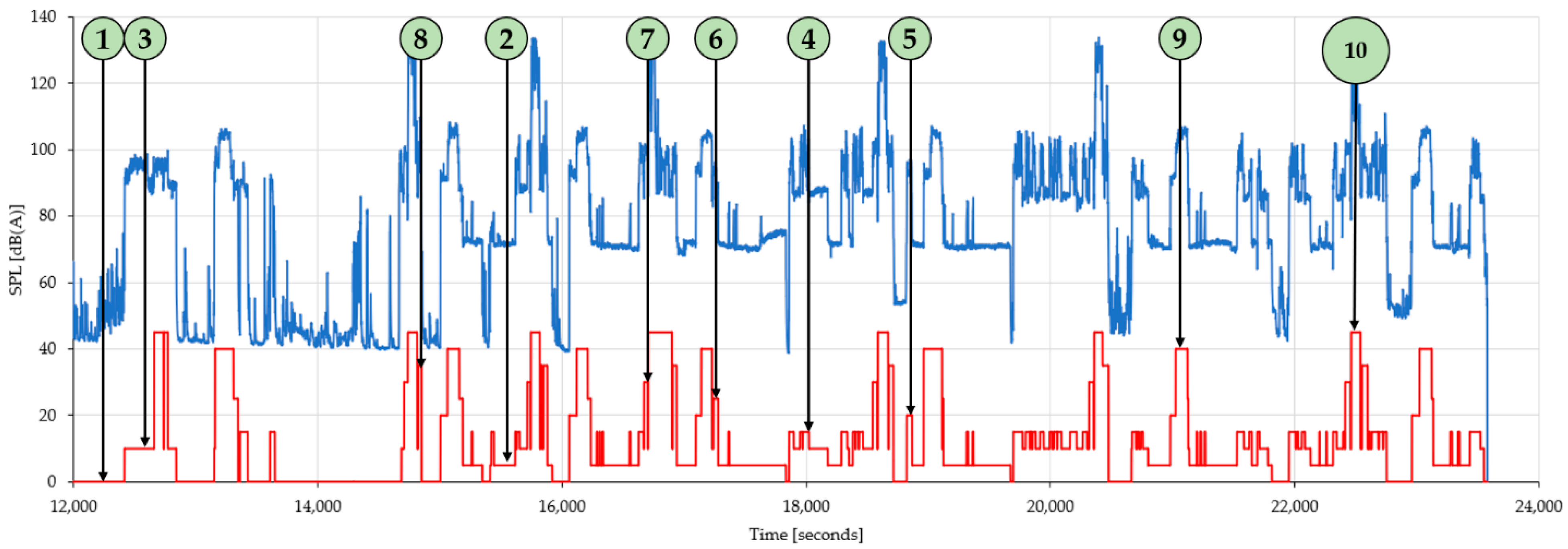
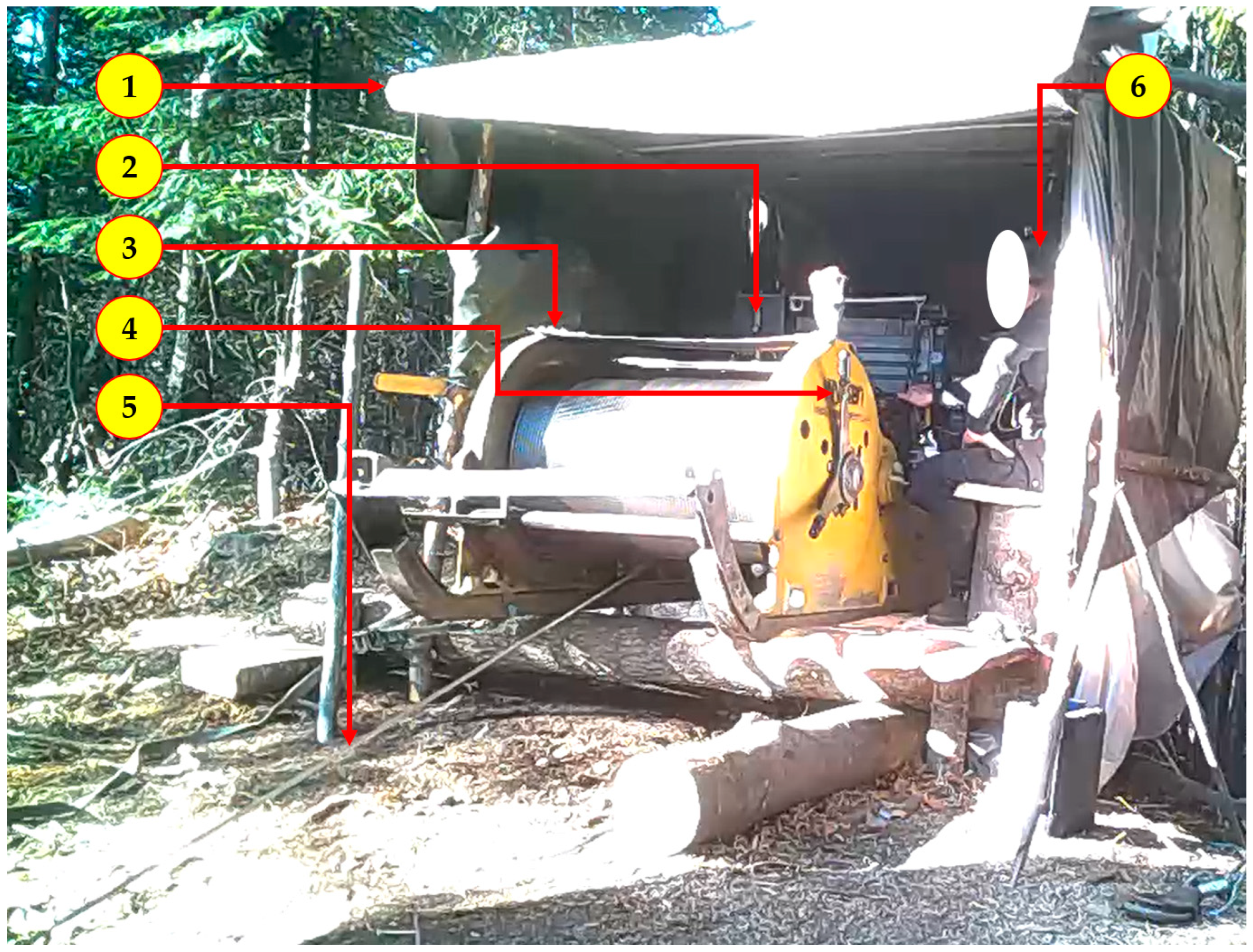
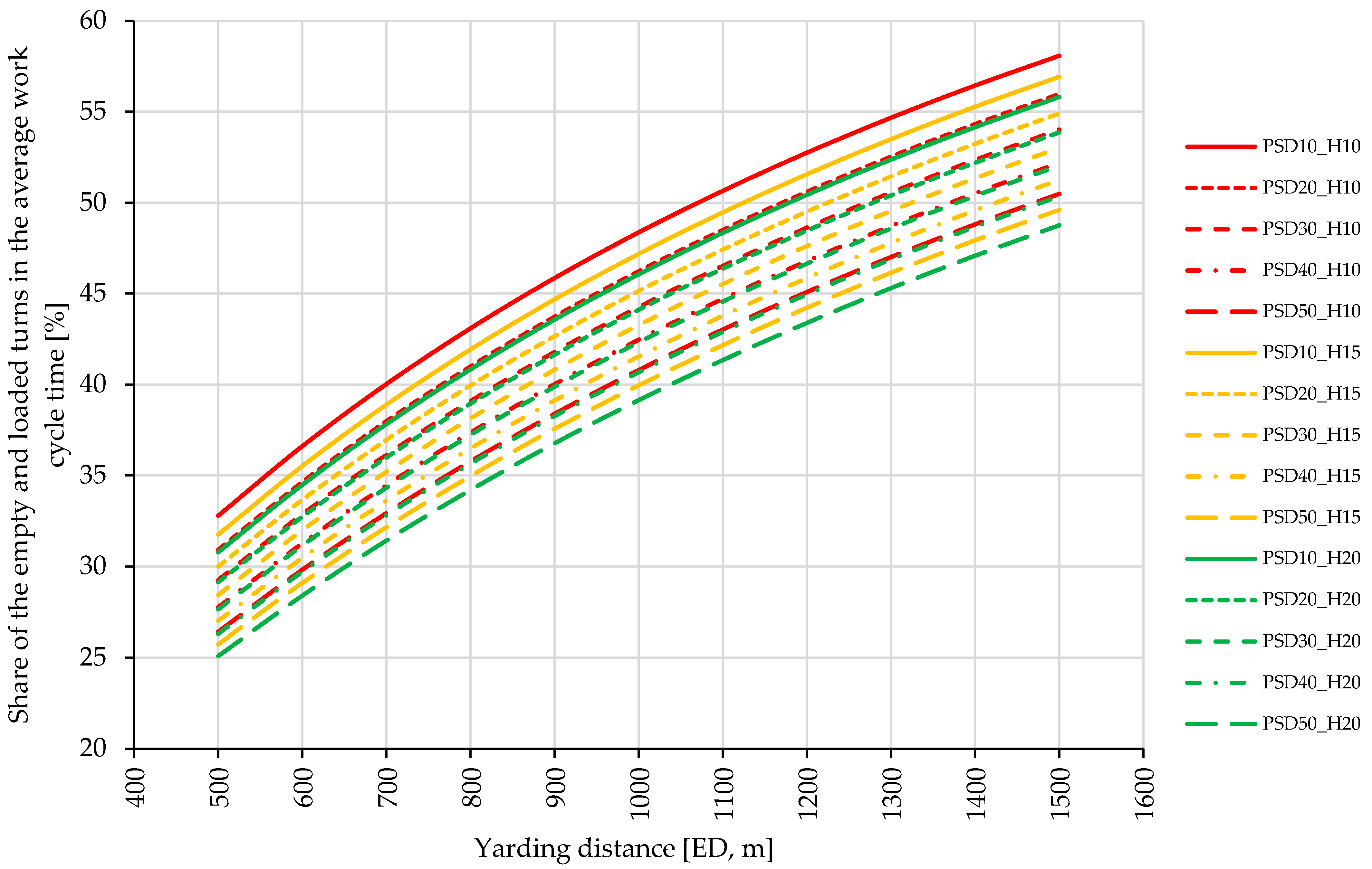
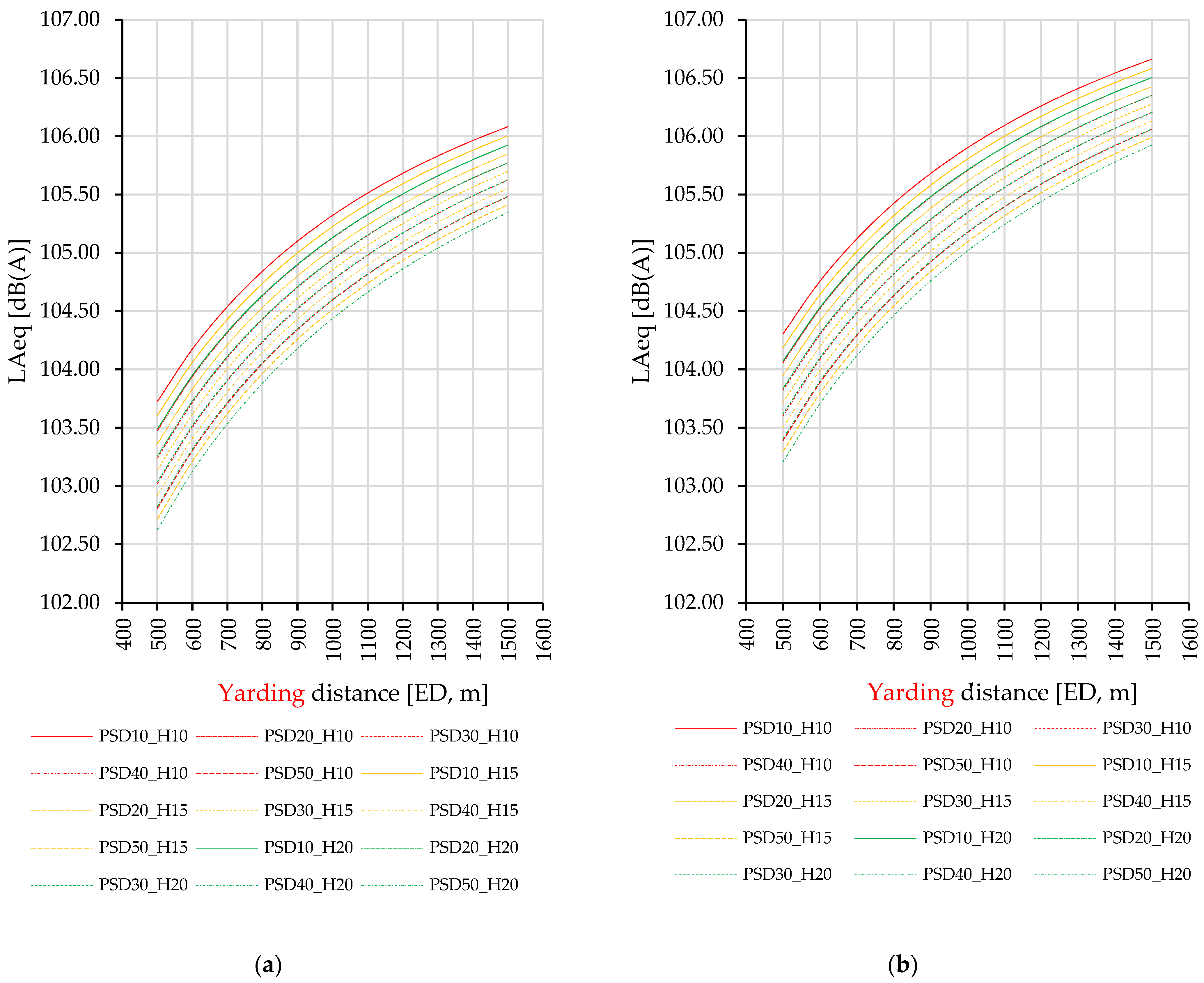

| Event 1 | Abbreviation | Description |
|---|---|---|
| Engine off | EOFF | Length of time the machine engine was found to be switched off as seen in the video files, with no other sources identified emitting noise. In this event, the only noise recorded was that of the surrounding environment, and it included the time spent to set up and position the data collectors. |
| Engine off, cooling | ECOOL | Length of time the machine engine was found to be switched off as seen in the video files, but with an additional source of noise, in addition to that of the environment, due to the activation of the engine cooling mechanism. |
| Engine on, no work | EON | Length of time the machine engine was found to be switched on as seen in the video files, but no active operation of the machine was observed in the media files. |
| Cable work | CW | Length of time the drum of the mainline was observed to be engaged to support lateral yarding, with or without the support of the engine. |
| Lifting the cable | LIC | Length of time the drum of the mainline was observed to be engaged, so as to lift the cable when the carriage was at the landing site with the support of the engine. |
| Lowering the cable | LOC | Length of time the drum of the mainline was observed to be engaged, so as to lower the cable when the carriage was at the lateral yarding place, mainly with the engine turned on. |
| Lifting the load | LIL | Length of time the drum of the mainline was observed to be engaged, so as to lift the load when the carriage was at the lateral yarding site with the support of the engine. |
| Lowering the load | LOL | Length of time the drum of the mainline was observed to be engaged, so as to lower the load when the carriage was at the landing site, mainly with the engine turned on. |
| Empty turn | ET | Length of time the drum of the mainline was observed to be engaged, so as to move the carriage from the landing to the lateral yarding site with the support of the engine. |
| Loaded turn | LT | Length of time the drum of the mainline was observed to be engaged, so as to move the carriage from the lateral yarding site to the landing site, mainly with the engine turned on. |
| Event | Abbreviation | Number of Observations | Minimum Value dB(A) | Maximum Value dB(A) | Median Value dB(A) | Mean Value dB(A) | Standard Deviation dB(A) |
|---|---|---|---|---|---|---|---|
| Engine off | EOFF | 15,035 | 38.8 | 99.9 | 47.9 | 50.5 | 8.89 |
| Engine off, cooling | ECOOL | 3288 | 60.8 | 83.4 | 71.3 | 71.5 | 1.47 |
| Engine on, no work | EON | 1488 | 69.1 | 98.7 | 87.0 | 87.8 | 3.43 |
| Cable work | CW | 1392 | 55.8 | 110.9 | 93.9 | 93.3 | 6.87 |
| Lifting the cable | LIC | 314 | 74.9 | 97.5 | 92.0 | 92.1 | 2.40 |
| Lowering the cable | LOC | 157 | 74.6 | 98.9 | 88.5 | 88.6 | 5.16 |
| Lifting the load | LIL | 207 | 78.9 | 103.5 | 99.7 | 99.1 | 3.42 |
| Lowering the load | LOL | 237 | 66.0 | 119.2 | 97.3 | 96.9 | 6.20 |
| Empty turn | ET | 775 | 81.3 | 108.3 | 104.0 | 102.5 | 4.25 |
| Loaded turn | LT | 681 | 85.8 | 134.5 | 111.1 | 111.3 | 15.60 |
| Event | Abbreviation | Hypothesized Mean dB(A) | Sample Mean dB(A) | p-Value | Population Mean dB(A) | Lower Confidence dB(A) | Upper Confidence dB(A) |
|---|---|---|---|---|---|---|---|
| Engine off | EOFF | 50.5 | 50.52 | 0.7436 | 50.52 | 50.38 | 50.67 |
| Engine off, cooling | ECOOL | 71.5 | 71.54 | 0.1492 | 71.54 | 71.49 | 71.59 |
| Engine on, no work | EON | 87.8 | 87.85 | 0.5851 | 87.85 | 87.67 | 88.03 |
| Cable work | CW | 93.3 | 93.31 | 0.9743 | 93.30 | 92.94 | 93.66 |
| Lifting the cable | LIC | 92.1 | 92.08 | 0.9033 | 92.08 | 91.81 | 92.34 |
| Lowering the cable | LOC | 88.6 | 88.65 | 0.9042 | 88.65 | 87.82 | 89.45 |
| Lifting the load | LIL | 99.1 | 99.14 | 0.8825 | 99.14 | 98.66 | 99.58 |
| Lowering the load | LOL | 96.9 | 96.94 | 0.9193 | 96.94 | 96.12 | 97.73 |
| Empty turn | ET | 102.5 | 102.50 | 0.9983 | 102.50 | 102.20 | 102.80 |
| Loaded turn | LT | 111.3 | 111.33 | 0.9598 | 111.34 | 110.16 | 112.52 |
Disclaimer/Publisher’s Note: The statements, opinions and data contained in all publications are solely those of the individual author(s) and contributor(s) and not of MDPI and/or the editor(s). MDPI and/or the editor(s) disclaim responsibility for any injury to people or property resulting from any ideas, methods, instructions or products referred to in the content. |
© 2024 by the authors. Licensee MDPI, Basel, Switzerland. This article is an open access article distributed under the terms and conditions of the Creative Commons Attribution (CC BY) license (https://creativecommons.org/licenses/by/4.0/).
Share and Cite
Borz, S.A.; Mederski, P.S.; Bembenek, M. A Simulation Study of Noise Exposure in Sledge-Based Cable Yarding Operations. Forests 2024, 15, 360. https://doi.org/10.3390/f15020360
Borz SA, Mederski PS, Bembenek M. A Simulation Study of Noise Exposure in Sledge-Based Cable Yarding Operations. Forests. 2024; 15(2):360. https://doi.org/10.3390/f15020360
Chicago/Turabian StyleBorz, Stelian Alexandru, Piotr S. Mederski, and Mariusz Bembenek. 2024. "A Simulation Study of Noise Exposure in Sledge-Based Cable Yarding Operations" Forests 15, no. 2: 360. https://doi.org/10.3390/f15020360
APA StyleBorz, S. A., Mederski, P. S., & Bembenek, M. (2024). A Simulation Study of Noise Exposure in Sledge-Based Cable Yarding Operations. Forests, 15(2), 360. https://doi.org/10.3390/f15020360








